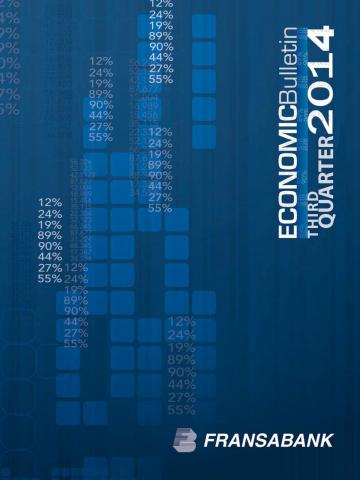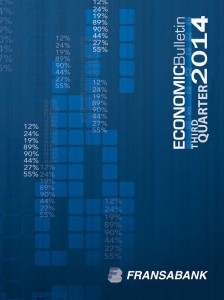
Beirut, November 28, 2014
In Fransabank's Economic Bulletin for the first nine months of 2014:
- Incessant unfavorable regional turmoil in several Arab countries affect negatively the economic performance and hence decrease the GDP growth forecast in Lebanon to nearly 1.8%.
Fransabank completed its economic bulletin for the first nine months of 2014, which included a report on the performance of the Lebanese economy during this period, and a study on the Lebanese Major Indices – Q3 2014.
The report noted that the Lebanese economy continued the slowdown in its general activity in the first nine months of 2014, as compared to the same period of the last year and its activity in the second quarter of 2014. This is shown by the weak performances in most indicators of the real sector. The construction permits increased by 6.8% up to the third quarter of 2014 relative to the same period of 2013. The number of property sales increased by 4.2%, the number of tourists by 4.2%, the amount of cleared checks by 4.5%, and the number of passengers at Beirut-Rafic Hariri International Airport by 4.1%.
The report explained that public finances improved in the first half of 2014 (as per the latest available data), as compared to the same period of last year, where the fiscal deficit decreased due to the lower increase in public expenditures as compared to the increase in public revenues. Total expenditures increased by USD 70 million to reach USD 6.8 billion in the first half of 2014, from USD 6.73 billion in the same period of 2013. While public revenues increased by USD 370 million to USD 5.2 billion during the first half of 2014 as compared to USD 4.83 billion in the same period of 2013. As a result, the fiscal deficit retreated by USD 300 million to USD 1.6 billion in the first half of 2014 as compared to USD 1.9 billion in the same period of 2013.
The report indicated that gross public debt increased by USD 3.6 billion to reach USD 66 billion in the third quarter of 2014 relative to USD 62.4 billion in the same period of 2013, while it increased by USD 300 million from USD 65.7 billion in the first half of 2014. Excluding the public sector's deposits at the Central Bank of Lebanon and commercial banks from the total public debt, the net public debt increased by USD 3.8 billion to reach USD 55.9 billion in the third quarter of 2014 relative to USD 52.1 billion in the same period of 2013, while it increased by USD 1 billion from USD 54.9 billion in the first half of 2014.
The report emphasized that the monetary situation remained relatively stable, in light of the monetary stabilization policy adopted by the Central Bank of Lebanon. The money supply (M3) expanded by USD 7.1 billion to reach USD 108.5 billion in the third quarter of 2014 relative to USD 101.4 billion in the same period of 2013, while it increased by USD 2.25 billion from USD 106.25 billion in the first half of 2014. Based on the data issued by the Central Administration of Statistics for the first nine months of 2014, the inflation rate was 2.3% as compared to 0.6% in the same period of last year, while it was 6.4% in the first half of 2014, while the Beirut Traders Association - Fransabank Retail Index stood at 54.45 for the third quarter of the year 2014 while it registered 78.23 in the third quarter of the year 2013. The Central Bank's FX assets increased by USD 2.6 billion to reach USD 38.3 billion in the third quarter of 2014 relative to USD 35.7 billion in the same period of 2013, while it increased by USD 1.2 billion from USD 37.1 billion in the first half of 2014.
The report explained that the banking sector continued its growth but at a slower pace in the first nine months of 2014, as compared to the average growth of the same period in the previous years. Total assets increased by USD 12 billion to reach USD 171.3 billion at end of September 2014 relative to USD 159.3 billion in the same period of 2013, while it increased by USD 800 million from USD 170.5 billion at end of June 2014. The private sector's deposits also increased by USD 10.6 billion to USD 142 billion at end of September 2014 relative to USD 131.4 billion in the same period of 2013, while it increased by USD 1.7 billion from USD 140.3 billion at end of June 2014. Total loans to the private sector increased by USD 4.05 billion to USD 49.95 billion at end of September 2014 relative to USD 45.9 billion in the same period of 2013, while it increased by USD 2.25 billion from USD 47.7 billion at end of June 2014.
The report pointed out that according to statistics of the Beirut Stock Exchange (BSE), total trading volume in the BSE increased by 44.8 million shares to reach 75.8 million shares in the third quarter of 2014 relative to 31 million shares in the same period of 2013, while it increased by 46 million shares from 29.8 million shares in the first half of 2014. The market capitalization increased by USD 570 million to USD 11.1 billion at end of September 2014 relative to USD 10.53 billion in the same period of 2013, while it decreased by USD 100 million from USD 11.2 billion at the end of the first half of 2014.
As for the external sector, the report showed that based on the data of the Higher Council of Customs, the value of imports decreased by 200 million to USD 15.7 billion in the third quarter of 2014 relative to USD 15.9 billion in the same period of 2013, while it increased by USD 5.4 billion from USD 10.3 billion in the first half of 2014. On the other hand, the value of exports decreased by USD 700 million to USD 2.5 billion in the third quarter of 2014 relative to USD 3.2 billion in the same period of 2013, while it increased by USD 800 million from USD 1.7 billion in the first half of 2014. As a result, the trade deficit increased by USD 500 million to USD 13.2 billion in the third quarter of 2014 relative to USD 12.7 billion in the same period of 2013, while it increased by USD 4.6 billion from USD 8.6 billion in the first half of 2014.
The report also noted that the value of net capital inflows to Lebanon increased by USD 800 million to USD 12.9 billion in the third quarter of 2014 relative to USD 12.1 billion in the same period of 2013, while it increased by USD 4.08 billion from USD 8.85 billion in the first half of 2014. This resulted from the continuous financial remittances from the Lebanese Diasporas to their relatives in Lebanon in addition to some Foreign Direct Investments (FDIs). As a result, the balance of payments recorded a decrease in its deficit account by USD 374.6 million to reach USD 301.8 million in the first nine months of 2014, as compared to a deficit of USD 676.4 million during the same period of last year, while the deficit increased by USD 517.5 million from a surplus of USD 215.7 million in the first half of 2014.
The report pointed out that the Lebanese economy is expected to achieve a real growth rate of 1.8% in 2014 as per the International Monetary Fund's estimates.
For Further Information, Kindly Contact
Categories
- Log in to post comments
